Betta fish, also known as Siamese fighting fish, have long been admired for their beauty and unique personalities. Originally found in the shallow waters of Southeast Asia, wild betta fish have become increasingly popular as pets due to their striking colors and fascinating behaviors. In this article, we will explore the world of wild betta fish, including their natural habitat, physical characteristics, and behavioral traits.
Natural Habitat
Wild betta fish are native to the slow-moving streams, rice paddies, and swamps of Southeast Asia, including Thailand, Cambodia, and Vietnam. In these areas, bettas can be found in shallow waters with plenty of vegetation, such as water lilies and floating plants. The water in these areas is typically warm, acidic, and low in dissolved minerals, which is important to consider when creating a suitable aquarium environment for pet bettas.
Physical Characteristics
Wild betta fish are small, typically growing to between 2-3 inches in length. They are known for their vibrant colors and elaborate fins, which are used to intimidate rivals and attract mates. Betta fish have a labyrinth organ, which allows them to breathe air from the surface in addition to gills. This adaptation allows them to survive in oxygen-deprived environments, such as the shallow waters of their natural habitat.
Behavioral Traits
Betta fish are known for their aggressive behavior, which has made them popular in the sport of fish fighting in some parts of the world. However, it is important to note that this practice is illegal in many countries and should not be condoned. In their natural habitat, male bettas will display aggressive behavior towards one another to establish dominance and secure breeding rights with females. Females, on the other hand, tend to be less aggressive and more social, often living in groups.
In addition to their aggressive behavior, bettas are also known for their unique personalities. Many betta owners report that their fish have distinct likes and dislikes, and some even seem to recognize their owners and respond to them in specific ways. Betta fish are also known for their elaborate courtship behaviors, which include flaring their fins, blowing bubbles, and creating elaborate nests out of bubbles and plant material.
Caring for Wild Betta Fish
While betta fish can make great pets, it is important to provide them with a suitable environment to ensure their health and well-being. In addition to clean water and appropriate food, bettas require plenty of space and hiding places in their aquarium. It is also important to avoid overfeeding, as bettas are prone to obesity and related health problems.
Conclusion
Wild betta fish are fascinating creatures that have captured the attention of people around the world. From their striking colors and elaborate fins to their aggressive behavior and unique personalities, bettas are a complex and beautiful species that are well worth exploring further. Whether you are a seasoned fish enthusiast or a newcomer to the hobby, bettas are a great choice for anyone looking to add some beauty and complexity to their aquatic world.
More informations about Wild Betta fish
Wild Betta Fish. The betta fishes are uniquely beautiful fish, and
they are found in unique environments, where other fish species
are unlikely to survive.
They are very colorful and beautiful fish, and you can find them on pet tanks at home.
Betta fish care is usually easy, which is why people prefer them as pets especially for their kids.
They are very territorial especially with their species as they prefer to be on their own.
The betta fish is unique fish, and they can breathe on water and out
of the water with a unique organ called the labyrinth.
This particular organ has enabled them to survive harsh conditions
as they can come to the surface and take in oxygen that will be enough for them.
Most fish species cannot survive in the harsh environment you will
find the betta fish, due to the reduced oxygen content, especially in the muddy water.
The betta fish is very beautiful with radiant color that makes them
stands out and looks attractive.
They are carnivores in nature and eat small animals like plankton,
mosquitoes, worms and other smaller species of animal.
The wide betta fishes are much more different than the regular betta.
Betta fish are mostly found in a warm climate, and they are predominantly found in the Asian region.
You can find betta fish in rice paddle, streams and water channels.
These environments are warm and not too big for the betta fish as
they are small and cannot easily compete with big species of fish in bigger water space.
The wild betta fish is usually much duller in color than most betta fish species.
The wild betta fish are typically brownish, and this can be attributed
to their ability to camouflage in muddy environments away from bigger prey.
This is one of their protective abilities that make it harder for them
to be sorted out in these muddy environments.
This does make it a little difficult in trying to catch them in the wild.
The wild betta fish also have smaller fins than the regular betta fish
which also enable them to stay safe in the wild.
With the smaller fins, they cannot easily be detected, and they can
swim easily through the rough water and don’t get trapped.
For a smaller animal, they can take care of themselves very well.
The male and female are very different, and you can easily distinguish them from one another.
The female wild betta fish is smaller in size and have smaller fins than the male betta fish.
The male betta fish are very protective of their territory that they
often chase away their female after laying eggs.
This is why two pet betta fishes in a tank usually fight each other often.
It is important to feed the betta fish regularly and keep them from eating their fins.
When they are hungry, they usually eat their fins, which is not healthy for the fish.
Eating their fins can lead to diseases as the betta fish becomes prone to infection.
Emerald-Green Betta
Betta smaragdina
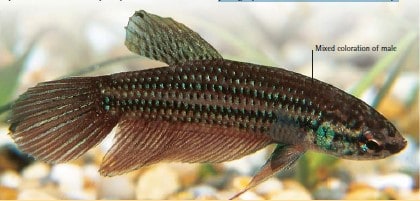
ORIGINS Southeast Asia, present in Cambodia
(Kampuchea), Laos, and eastern parts of Thailand.
SIZE 21⁄4 in (7 cm).
DIET Prepared foods and livefoods.
WATER Temperature 75–82°F (24–28°C); soft
(50–100 mg/l) and acidic (pH 6.0–6.5).
TEMPERAMENT Males may quarrel.
The body of the male Emerald-Green Betta displays areas of red,
blue, and green.
The female is plainer, but will develop stripes as the time for spawning approaches.
Males can be mixed with unrelated fish, but if they are housed
together, they will fight, with potentially fatal consequences.
In the wild, Emerald-Green Bettas inhabit shallow areas of water
that flood during the wet season,and this flooding marks the onset of the breeding period.
A significant partial water change in their tank may thus trigger
spawning.The male builds a bubble-nest among vegetation.
After spawning, remove the female in case the male becomes
aggressive toward her, and leave the male to guard the nest, which contains up to 100 eggs.
Give the young fry food at first and then brine shrimp.
Mouth-Brooding Betta
Betta pugnax
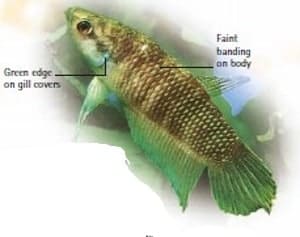
ORIGINS Southeast Asia; occurs widely on the Malay
Peninsula.
SIZE 4 in (10 cm).
DIET Prepared foods and livefoods.
WATER Temperature 73–77°F (23–25°C); soft
(50–100 mg/l) and acidic (pH 6.0–6.5).
TEMPERAMENT Males likely to be pugnacious.
The appearance of these fish is highly variable, depending partly on
their origins and partly on their overall condition.
They tend to have a reddish-brown background color, with green
spots evident on the individual scales.
Cooler water conditions suit this mouth-brooder, which often
occurs in flowing waters.
The young are sexually mature by about six months.
Slim Betta
Betta bellica
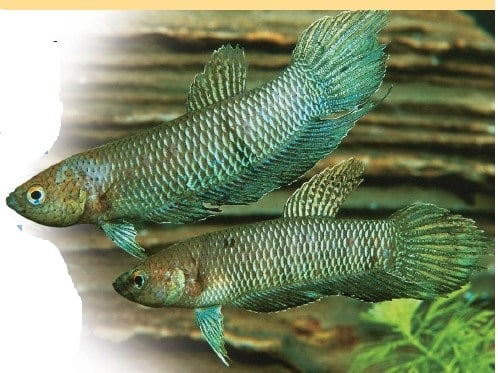
ORIGINS Southeast Asia, where its distribution is
centered on the Malay Peninsula.
SIZE 41⁄2 in (11 cm).
DIET Prepared foods and livefoods.
WATER Temperature 75–82°F (24–28°C); soft
(50–100 mg/l) and acidic (pH 6.0–6.5).
TEMPERAMENT Males only aggressive when breeding.
JAW SHAPE AND BREEDING
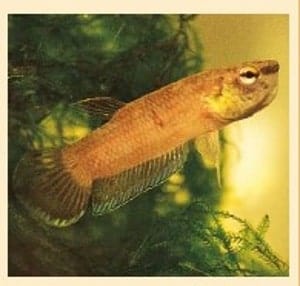
Head structure is a good guide to breeding habits in Betta species. The jaws of mouthbrooders are modified to provide more space in
the oral cavity for the developing brood.
As a result, the head is taller and the jawline less rounded, as seen in
this Krabi Mouth-Brooder (Betta simplex).
Bubble-nesting species have smaller heads, since they simply have
to pick up the eggs and transfer them to the nest.
The enlargement of the oral cavity in mouthbrooders only
develops when the fish become sexually mature, and it is only seen
in the sex that is responsible for brooding the young.
Wine-Red Betta
Betta coccina
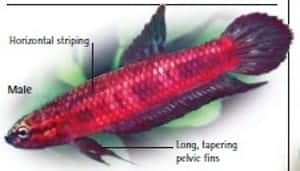
ORIGINS Southeast Asia, present on Sumatra and the
southern tip of the Malay Peninsula.
SIZE 21⁄2 in (6 cm).
DIET Prepared foods and livefoods.
WATER Temperature 75–82°F (24–28°C); soft (50 mg/l)
and acidic (pH 5.0–6.0).
TEMPERAMENT Males are aggressive toward each other.
The Wine-Red Betta first became available to hobbyists in the 1980s.
The body color that gives the fish its name is restricted to the male; the female is decidedly brownish. Males must be kept individually, to prevent fighting.
Water quality is especially important for the health of this rather
delicate species, and peat filtration is advisable.
Up to 60 eggs form the typical brood, and both parents can be safely left with their young.
Crescent Betta
Betta imbellis
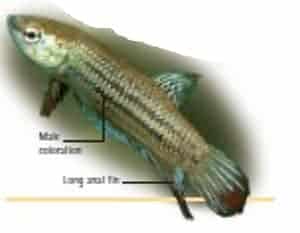
ORIGINS Southeast Asia, on the Malay Peninsula and
nearby islands, notably Phuket and Pinang.
SIZE 2 in (5 cm).
DIET Prepared foods and livefoods.
WATER Temperature 75–82°F (24–28°C); soft
(50–100 mg/l) and acidic (pH 6.0–6.5).
TEMPERAMENT Males may fight each other.
Male Crescent Bettas are more colorful than females, their brownish bodies displaying bluehues.
There are distinct regional variations, withfish from Pinang Island being yellowish in
color.
Male Crescent Bettas are far from docile,especially when in
breeding condition.
If well-fed,a pair of these bubble-nesting fish
will spawnseveral times in quick succession,producing as many as 150 eggs per batch.
How Does Wild Betta Fish Survive
For those that are not usually familiar with the betta fish, you may
be wondering how the betta fish survive in a warmer climate and their habitat such as the rice paddle.
The rice paddles usually go dry seasonally, so how does this betta fish survive these changes.
The betta fish developed the ability to breathe underwater and in the air. And we said this is made possible through the special organ they call labyrinth.
They can breathe the oxygen present in water or will swim to the
air to breath whenever the oxygen in the water reduces.
This gives them an advantage in the normal habitat where you can find them as the water is usually muddy.
The betta fish can also survive for a while in a dried up area.
This is because of the organ they possess to breathe oxygen in the air.
The small fins of the wild betta fish do make it difficult to be seen or noticed along with its muddy color brown.
This character does make it also difficult for us to capture these wild betta fish.
So why do people catch betta fish?
Betta fishes are usually captured for their beauty and are mostly kept as a pet. In the earlier years, the king of Thailand usually uses them as a sport.
They are used to stage fight because of their fighting abilities
especially when two males are kept in a tank.
And though they are not mostly kept for sports purposes nowadays, they are more being kept as a pet.
Catching a Wild Betta Fish beta fishing
If you want to catch a wild betta fish, you have to understand more about the fish.
You have to understand its habitat to know where you are going to go fishing for them.
You will also have to know about their body structure, so you do not
harm them in any way when you capture the or during transporting them.
You will need a kind of hand net or basket to catch a wild betta fish
and probably a small container filled with water to store them before you transport them.
You will not go to a freshwater environment if you are looking for a wild beta fish.
That is why you will need to understand more about the environment. As we said earlier, you can find these kinds of fish in the Asian regions or warm water environments.
So let’s look at the ways you can catch a wild betta fish!!!
The wild betta fishes are very defensive and evasive more than the normal betta fish.
You cannot easily spot them in the muddy water due to their brownish color.
This gives them a camouflage sense of security. And you cannot easily catch them with a line because of their sizes.
One of the ways you can catch a wild betta fish is to use a small hand net.
The wild betta fish are very small so that the hand net will be very tiny, so the betta fish does not escape out of the net.
Also, a smaller net will ensure that you do not hurt the fish especially when their fragile fun gets stuck.
Using Hand net to Catch Betta Fish
The wild betta fish are not easy to see in the muddy water as they
can easily camouflage with their brownish or muddy color.
So what you should do with the hand netball to comb the area in a tangent.
Since they are located in shallow water, you can move over the
water body with your boot as you use your hand net to comb the area.
Now, when you insert your net in the water, you raise it up and
watch as the water sips out and if they are wild beta fish, they will be stuck in the net.
So what you will do is to inspect the net and picked out any wild betta fish you found caught on the net.
You will have to transfer the betta fish you find from the net to a water container you carry along with you.
Wild betta fish can stay away from water for some time as they can take oxygen from the air.
But you will have to put them in the water as you may have to transport them for a long distance.
You should be careful when you picked the wild betta fish from the net and transported them to the water jar.
They are very fragile and can easily slip for your hand back to the water.
You should be very observant when searching the hand fishing net
as these fishes might be hiding behind leaves or small muddy
stones and you will have to throw them back to the water.
You have to do this in tangent to be able to comb the entire water body. It can be a long and enduring task as you go around the water body.
Catching Wild Betta Fish in Dried Land
You can find wild betta fish in dried up warm environment as they
can still breathe outside water with their labyrinth organ.
They can easily jump back to the water body. Thus you have to be fast if you want to catch them.
You can look out for wild beta fish as the rice puddle begins to dry
up and they stick around for awhile before moving on to the water body.
You can grab them with your hands easily since they cannot swim fast when in the drier environment.
You can still miss because they usually not as obvious when they camouflage like the mud.
They can be very obvious except when they jump.
So they are more difficult to catch on dry land than when they are in the water.
You can still carry your hand net along to help you trapped them especially when they are jumping around.
You can throw your net to cover the area you saw them jumped into and try and sort them out with your hands.
You should be very careful in picking out the wild betta fish from
dry land as they are very vulnerable when they are on dry land.
Spreading Net over a Considerable Length
You can spread a large net over a considerable length over a rice paddle farm and leave it for awhile.
When you come back, you can start picking out the wild betta fish caught in the net. T
hey usually got caught in the net as they move around the water body looking for food.
You should also understand that the wild betta fish usually comes to
the surface to take in oxygen as the muddy water usually lacks enough oxygen.
As they move up and down, they will get caught in the net, and
since the water body is not much deep, it will be easy to trap these wild betta fish.
This is a much easier way to catch the wild betta fish, and you can do this best when the water body is high and not dried up.
With casting the net over a larger area, you can catch more wild
betta fishes than using any other method to catch this fish.
Why Do We Catch Wild Betta Fishes
Wild betta fish have become more popular in recent times than
before, and they have also become scarcer.
You will find most homes with colorful betta fishes on their fish tanks as they are easy to feed and take care of as a pet.
Most parents usually give out betta fish as the first pet to their
young ones as a way of getting them to learn how to take care of an animal.
And because of the destruction of their habitation by man action
and other factors, the breeding of wild betta fishes are being
encouraged to keep the species from going extinct.
Most preservationists are worried that if we leave them in their
natural habitat, they may be destroyed along with their habitat environment being destroyed.
So what is being done is that they are being caught and breed in fish
tanks and this will help to keep the species non-extinct.
It has become a business for some as they catch these wild betta fish
and breed them in a tank and sell them when they start reproducing.
So it has become a bigger business selling these exotic fishes to those who want them in their homes.
The wild betta fish does thrive in particular environmental
conditions; they dwell better in a warm water environment
. They do not thrive at all in cold environment, and you should try
as much as possible to keep them warm especially when you have them in tanks.
One of the most advantageous things of having a wild betta fish as a
pet is that they can survive alone in the tank and as well as with other species of animal.
They usually have a problem with their specie and will fight with
another wild betta fish when placed in the same tank.
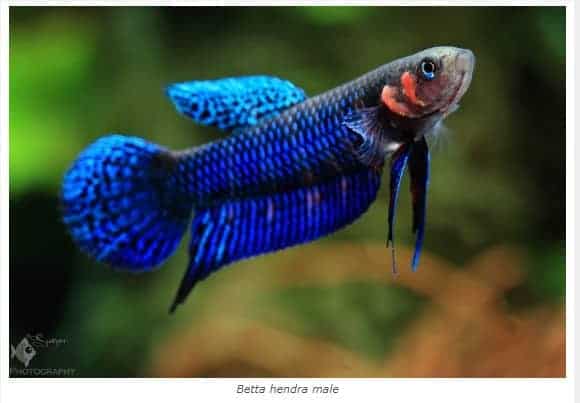
Can you find betta fish in the wild?
Wild bettas live in shallow, freshwater areas. They prefer ponds, streams, canals and rice paddies, but they are also found in rivers.
They feed upon plankton, mosquitoes and insect larvae. Bettas are
known as fighting fish because two males in close proximity will
fight with one another for dominance.
What do betta fish eat in the wild?
Wild Betta fish are hardy and can eat almost anything in their
environments, including worms, larvae of mosquitoes or other
insects, and even smaller fish.
Their natural environment is often resource-limited, so many
Betta species have little choice of food.
Where are betta fish naturally found?
The betta comes from parts of Vietnam, Malaysia, Thailand and
Cambodia in the river basins of the Mekong and Chao Phraya rivers.
They are found in rice paddies and drainage ditches, river basins and small streams.
Do betta fish exist in the wild?
Wild bettas live in shallow, freshwater areas. They prefer ponds, streams, canals and rice paddies, but they are also found in rivers.
They feed upon plankton, mosquitoes and insect larvae. Bettas are
known as fighting fish because two males in close proximity will
fight with one another for dominance.
How long do betta fish live in the wild?
Also called Siamese Fighting Fish, bettas are very popular pets.
They can be easy to care for, and, under the right circumstances, they can live for several years.
Wild betta live, on average, two years. However, in captivity, with the right care, a betta can live four years or more.
wild betta species
Betta splendens, the species usually sold at big box pet stores, does
not exist naturally in the wild, and it is very popular in the aquarium hobby so it’s unlikely to go extinct.
Wild-type bettas of different species, however, are much more at risk.
Their habitat I’d shrinking and becoming polluted, and although
many people keep these other species of betta in aquariums as well
, they don’ have the domestic popularity to assure their survival.
Wild bettas outside of the betta splendens species are considered threatened.
wild betta fish natural habitat
Why are we discouraged from using rainwater for our aquariums
when the natural habitat of bettas experience rain throughout the year?
Very simple, because fish do not live in rain water!
Logically speaking – Yes lakes and ponds and river take rainwater…. but never rain water replace 100% of the original water body.
(Well maybe in some rare exceptional case but then even the
minerals in the ground would leech into the rain water).
So no fish live in rain water
Additionally
All fish depending on the specie, requires a certain degree of
minerals to live depending on the specie.
And rain water is somewhat just pure H20 with some
contamination from the air and completely lacking in minerals like calcicum, iron,….
In Amazon area where it rains really heavy + some area water just
stand there then you get a big body of water consist of mostly rain water.
In this case the water would be very soft but it still has some
minerals from the ground and tannis from decaying organics
matters, not pure rain water -> Which results in fish like Discus,
Angelfish prefer softer water with less minerals but MINERALS ARE STILL A MUCH AT A VERY LOW LEVEL.
Then we got place like malawi lake -> Less rain. lots of rocks and minerals => very hard water.
These fish will die for sure if they live in an environment with rain water.
So yes. Rain water can be used to substitute the practice of mixing
RO water with minerals/tap water to achieve softer water.
However be very careful with rainwater too because if the air is
polluted, the water will be contaminated with all sort of things you won’t know. So still its best to use RO water instead of rain water
Where do betta fish come from?
They come from Thailand! At least, that’s where it’s most commonly cited.
More broadly they come from Southeast Asia, so anywhere in the
area of Thailand, Indonesia, Vietnam–you’ll find wild Bettas in any
part of the world that used to be called “Siam” (which is where we get the name “Siamese Fighting Fish”).
Wild Bettas live in the connected streams between rice paddies and
flood plains, and people started harvesting them in the 1800s to use in fish fights.
Pretty cruel, and unfortunately still a practice that probably exists
in some places, but eventually the bigger and more colorful ones
started being bred for aesthetic purposes, which led to the Bettas you find in pet stores today.
Domestic Bettas look very different now from wild ones, but they
didn’t manage or care to breed out the aggression, which is why we still have feisty little friends. 🙂
Where do you find betta fish in the wild?
The betta comes from parts of Vietnam, Malaysia, Thailand and Cambodia in the river basins of the Mekong and Chao Phraya rivers. They are found in rice paddies and drainage ditches, river basins and small streams.
What is a wild betta?
Betta, /ˈbɛtə/ is a large genus of small, often colorful, freshwater ray-finned fishes, known as “bettas”, in the gourami family (Osphronemidae). The best known Betta species is B. splendens, commonly known as the Siamese fighting fish.
Do betta fish recognize their owners?
You’ve probably seen betta fish at your local pet stores or even grocery store. … Betta are quite intelligent as fish go, and they can even be trained to recognize their owners and do tricks.
They require stimulation and space to live well, and, as you might suspect, a tiny plastic cup doesn’t provide that.
Do betta fish get lonely?
It’s not that bettas have poor manners, but rather that they simply do not like nor need the company of other fish. Their lack of friends does not cause them to become bored, but you may include certain species in the same tank as your betta. … Although they’re not fish, snails generally work well together with bettas.
betta fish in the wild
In the wild, bettas live in Asia, where their homes are the shallow waters of rice paddies, ponds, or slow-moving streams. Since those waters aren’t deep, they stay warm, which is why bettas who live in human homes need at least 10 gallons of water in an aquarium that can be kept heated to at least 75 degrees.
Betta splendens are native to Thailand, Cambodia, Laos and Vietnam, where they live in ditches, rice paddies, shallow pools and slow moving streams. … Bettas are carnivores, feeding primarily on insects and insect larvae in the wild. They thrive on protein-based frozen, pellet and flake foods in aquariums.
1 question people ask about bettas is, “How do bettas mate in the wild without killing each other?” In fish keeping, betta owners are told that if they want to breed
wild betta splendens
Betta splendens are native to Thailand, Cambodia, Laos and Vietnam, where they live in ditches, rice paddies, shallow pools and slow moving streams
wild betta habitat
Bettas live in rice paddies and river basins. Their natural territory is about three-feet square. The areas in which they live are relatively shallow and thick with vegetation. The streams are slow-moving and in the dry season can easily evaporate to almost nothing
wild betta imbellis
Similar species would be all splendens complex members. Identification, Imbellis have green or blue gill plates with no wild spots on the tail rays.
wild betta fight
Male betta fish fight each other because they are incredibly territorial. In the wild, bettas have miles of rivers and paddies to swim through when it’s not drought season. When one male enters another’s territory, the two may show aggression, but a fight may not happen with plenty of room to retreat.
If you want to learn more on How to Help you Betta to live longer
where do wild betta fish live
wild betta macrostoma often called Brunei beauty is one of the most popular mouthbrooding wild betta fish. Its bright orange
wild betta singapore
wild betta types,
rare wild betta according to ibc
wild betta fish people also ask
Can betta fish be found in the wild?
Image result for wild betta fish
Habitat. Betta fish originated from Thailand but can be found in nearby countries such as Malaysia, Indonesia, Vietnam, Laos, and Cambodia. Wild bettas live in shallow, freshwater areas such as rice paddies, stagnant ponds, marshes, and slow-moving streams.
What is a wild betta?
Wild betta fish are a dull greyish-green with short fins; nothing like the spectacularly colored, long-finned beauties of today! Through selective breeding, a wide range of colors and fin types have been developed, including: veil, delta, halfmoon, crowntail, double tail and many more.
Are wild bettas rare?
Are Wild Bettas Rare? Wild Bettas can still be found in their natural habitats in Asia. They are not so rare a genus as a whole, but certain species are considered more rare to find in the wild than others. The fact that their natural habitats are being destroyed and polluted more often doesn’t help this species.
What are wild bettas called?
Betta imbellis often called the peaceful betta or crescent betta is one of the more known wild betta types. And if you look at it’s appearance, it’s no wonder why. Betta imbellis is easily recognizable by its green color all over the body and the red eclipse on the caudal fin
How long do bettas live in the wild?
about two years
Betta fish can live in the wild for about two years.
They have shorter lifespans in their natural habitat than when living in captivity because wild bettas are prone to living in more polluted and aggressive environments than pet bettas
How big do bettas get in the wild?
Image result
2.4 to 3.1 inches long
In the wild, the animals munch on unlucky insects that fall into the water, as well as small crustaceans, mosquito larvae and other aquatic arthropods. Bettas are usually small, from 2.4 to 3.1 inches long (6 to 8 centimeters), and live for about two years on average.
Are wild bettas harder to keep?
Most people have the impression that wild type bettas are difficult to keep, but they are not much different from any other fish at your local fish store. For beginners that are completely green to fish keeping in general, wild bettas MAY not be for you unless you are willing to do some research.
Can wild bettas be kept together?
The good thing about Wild Bettas is that they are actually not wilder than their domesticated species. If you put two males into the same tank, they are going to live peacefully together.
Are wild type bettas more aggressive?
As predicted, the short-finned domesticated strains were significantly more aggressive than wild-type B. splendens. However, the difference in aggression manifested itself only in the mutual-viewing test, which is the test that most closely resembled an actual fight. Betta splendens and the closely related B.
How much do wild bettas cost?
Betta macrostoma
Since then, given its rarity and beauty, many aquarists are eager to get their hands on a pair. The fact that these betta fish can cost up to $300 doesn’t stop them! Its body colors are similar to that of B. albimarginata, although the fin markings differ; B.
How high can Wild bettas jump?
How High Can Betta Fish Jump? You’ll be surprised to know that betta fish can jump quite high. In fact, for how small they are, it’s impressive. The average betta can jump 2-3 inches out of the water.